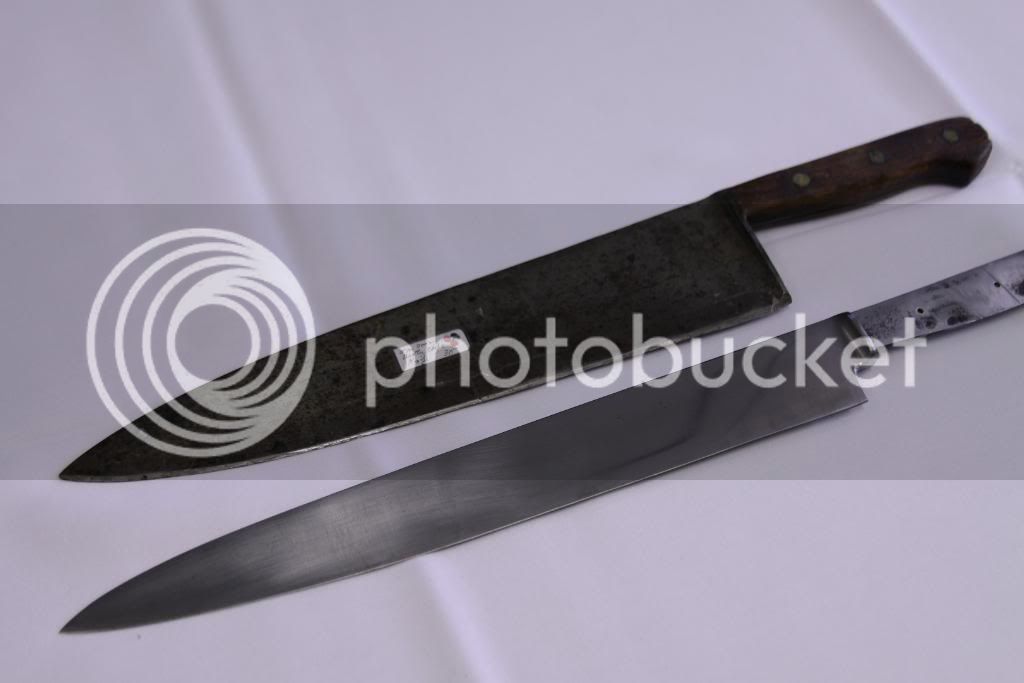Hi all,
I have a ~5 year-old set of Wusthof Classics that are in need of some TLC. They haven't seen any maintenance other than grooved and ceramic steels, and they're now quite dull as you'd imagine after 5 years of (home) use on the factory edge.
I'd like to bring them back up to respectable cutting performance, and was hoping to get some advice here, to either confirm or correct the impressions I've gotten after doing some research on my own.
I'm guessing a simple ~20* bevel (or a 15/20 double bevel as illustrated in Chad Ward's eGullet article) would wind up being sharper than "new" on these blades, and would be achievable with a combo 1k/6k waterstone? Am I barking up the wrong tree here?
I've filled out the "What knife should I buy" questionnaire, in case any of the answers to those question might influence how I should deal with these knives (I'm mainly concerned w/ the 8" chef's knife here):
What type of knife(s) do you think you want?
Big old thick, soft Soligen steel - already own 'em
What do you like and dislike about these qualities of your knives already?
Aesthetics- Fine; conservative & plain
Edge Quality/Retention- Can't complain; seemed "Stupid sharp" when new, stayed "sharp enough" for years w/ minimal maintenance (probably not by this forum's standards though)
Ease of Use-I don't really have anything profound to say here? I like the shape of the blade and the way it works on the board as-is.
Comfort- Like the heavier Euro-style blade/balance; picked Wusthofs over other makes tried at purchase (Henkels, Shun) because they "felt better" in the hand.
What grip do you use? Switch between pinch grip & finger point grips, depending on what I'm doing.
What kind of cutting motion do you use? Rocking, push cut, walk (in order of frequency)
Where do you store them? Block, edge up or to the side
Have you ever oiled a handle? Composite, so no.
What kind of cutting board(s) do you use? Plastic (meat), wood (veggies)
For edge maintenance, do you use a strop, honing rod, pull through/other, or nothing? Grooved steel included w/ set, and Ikea ceramic rod "steel"
Have they ever been sharpened? No. :O
What is your budget? <$100 to start (materials)
What do you cook and how often? Typical American dinner fare, 4-5 nights/week
I realize I could send these out to be sharpened, but where's the fun in that? Any advice that will help me improve these blades, rather than destroy them, is greatly appreciated.
Thanks!
-pilot
I have a ~5 year-old set of Wusthof Classics that are in need of some TLC. They haven't seen any maintenance other than grooved and ceramic steels, and they're now quite dull as you'd imagine after 5 years of (home) use on the factory edge.
I'd like to bring them back up to respectable cutting performance, and was hoping to get some advice here, to either confirm or correct the impressions I've gotten after doing some research on my own.
I'm guessing a simple ~20* bevel (or a 15/20 double bevel as illustrated in Chad Ward's eGullet article) would wind up being sharper than "new" on these blades, and would be achievable with a combo 1k/6k waterstone? Am I barking up the wrong tree here?
I've filled out the "What knife should I buy" questionnaire, in case any of the answers to those question might influence how I should deal with these knives (I'm mainly concerned w/ the 8" chef's knife here):
What type of knife(s) do you think you want?
Big old thick, soft Soligen steel - already own 'em
What do you like and dislike about these qualities of your knives already?
Aesthetics- Fine; conservative & plain
Edge Quality/Retention- Can't complain; seemed "Stupid sharp" when new, stayed "sharp enough" for years w/ minimal maintenance (probably not by this forum's standards though)
Ease of Use-I don't really have anything profound to say here? I like the shape of the blade and the way it works on the board as-is.
Comfort- Like the heavier Euro-style blade/balance; picked Wusthofs over other makes tried at purchase (Henkels, Shun) because they "felt better" in the hand.
What grip do you use? Switch between pinch grip & finger point grips, depending on what I'm doing.
What kind of cutting motion do you use? Rocking, push cut, walk (in order of frequency)
Where do you store them? Block, edge up or to the side
Have you ever oiled a handle? Composite, so no.
What kind of cutting board(s) do you use? Plastic (meat), wood (veggies)
For edge maintenance, do you use a strop, honing rod, pull through/other, or nothing? Grooved steel included w/ set, and Ikea ceramic rod "steel"
Have they ever been sharpened? No. :O
What is your budget? <$100 to start (materials)
What do you cook and how often? Typical American dinner fare, 4-5 nights/week
I realize I could send these out to be sharpened, but where's the fun in that? Any advice that will help me improve these blades, rather than destroy them, is greatly appreciated.
Thanks!
-pilot





